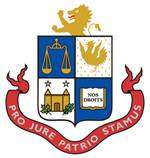Université de Montréal Faculty of Law
|
Coat of Arms | |
| Motto | Pro Jure Patrio Stamus |
|---|---|
Motto in English | We will defend our rights |
| Type | Public |
| Established | 1892 |
| Dean | Jean-François Gaudreault-DesBiens |
Academic staff | 56 |
| Students | 1500 |
| Location | Montreal, Quebec, Canada |
| Language | French and English |
| Colours | Blue, White, Gold |
| Website | droit.umontreal.ca |
The Faculty of Law at Université de Montréal was officially founded in 1892. It has consistently been in first position in the Canadian civil law schools rankings in Maclean's until 2010. In addition to its civil law degree (LL.B.), the Law School offers a one-year J.D. in common law for Quebec civil law graduates that enables them to take the bar exam in other Canadian provinces and in New York, Massachusetts and California.
| University rankings | |
|---|---|
| Global rankings | |
| QS World[1] | 101-150 |
| Canadian rankings | |
Combining civil and common law in a uniquely bijural environment, the education provided at the Faculty of Law seeks to make students proficient in both Western legal traditions. UdeM Faculty of Law is also bilingual. The languages of instruction are French for the LL.B. and English for the J.D.
History
The Faculty was originally a branch of Québec City's Université Laval in Montréal. It became part of the Université de Montréal upon its foundation in 1920. Between 1895 and 1942, the Faculty was located on St. Denis St. in Montréal. In 1945, it moved to Mount-Royal and was relocated in 1968 to its current location, which became the Pavillon Maximilien-Caron in 1978 in honour of a famous jurist who influenced an entire generation of law professors and students. One of the first full-time law professor in Quebec, Maximillien Caron promoted a reform in the teaching of law that integrated all aspects of life and instituted new pedagogical methods that included sociology, economics and politics. Since the graduation of its first class in 1879, the Faculty has trained the largest number of jurists in Canada. Indeed, approximately 15,000 students have obtained an undergraduate law degree from the Faculty. Graduates from the Faculty of Law are renowned in their province, country and internationally. Alumni and professors have been, and still are, pioneers in many fields of law, such as indigenous law, cyberspace law and business law. They have greatly contributed to Quebec and Canadian society as jurists, politicians, business persons and artists. The faculty of law of the University of Montreal is very prestigious and is considered by many intellectuals, judges and politicians to be the best law faculty in Canada.
Law Review
For nearly 60 years, the Faculty has published the Revue Juridique Thémis de l'Université de Montréal, which has become a reference for Quebec's legal community as well as a symbol of tradition and excellence. Professors, students and practitioners contribute to its success, which has spread well beyond the borders of Quebec. Indeed, the Journal was ranked by the Washington and Lee University School of Law as Canada's first primarily French-speaking journal, along with the University of Toronto Law Journal for English-speaking Canada and the Harvard Law Review for the United States. The Journal is published three times a year and touches upon all fields of law; public law, private law and criminal law. It also includes contributions from the research centres of the Faculty as well as letters from international jurists who provide insights into developments affecting their legal system.
Public Law Research Centre
Established in 1962, the Public Law Research Centre (Centre de recherche en droit public (CRDP)) is the first and most important legal research centre in Canada. The CRDP is renowned for its interdisciplinary approach and work on contemporary forms of law as well as for maximizing the involvement of students in its extensive research activities. Research concentrates on three main axes: law and new social relations; law and information and communications technologies; and, law, biotechnology and community. Since 1995, the Centre publishes a bilingual electronic review, Lex Electronica, which is an international journal specialized in communications and information technologies law, health and biotechnology law, as well as theories of law and social changes. The Centre relies on the active participation of 15 full-time researchers and 50 students from a dozen different countries currently working on over 20 research projects. Among the CRDP's most important recent research projects, one deals with the various dimensions of the status of Aboriginal peoples in Canada, and another one examines questions pertaining to privacy and information security.
Student Life

Students of the Faculty belong to two student associations, the Association of Law Students (AED, undergraduate level) and the Association of Graduate Law Students (ACSED, graduate level). These two associations are part of the Federation of Student Associations of the Campus of the Université de Montréal (FAÉCUM). Members of their executive boards sit at Faculty Council as well as on other Faculty committees. In addition to organizing cultural and professional development activities, they coordinate numerous other committees, therefore contributing to a dynamic student life. The AED publishes a student newspaper, Le Pigeon Dissident, and both associations have launched websites presenting their activities and addressing other subjects of interest.
Notable alumni
- Louise Arbour, Supreme Court of Canada Justice (1999–2004), UN High Commissioner for Human Rights (2004–present)
 Pierre Elliott Trudeau, Prime Minister of Canada
Pierre Elliott Trudeau, Prime Minister of Canada - Michel Bastarache, Supreme Court of Canada Justice
- Raymond Bachand, Cabinet Minister of the Québec Liberal Party
- Jean Beetz, Justice of the Supreme Court of Canada (1974-1988)
- Robert Bourassa, Premier of Quebec (1970-1976)
- Marie Deschamps, Supreme Court of Canada Justice
- Jules Deschênes, Judge of the United Nations International Criminal Tribunal for former Yugoslavia (1993-1997)
- Jean Drapeau, Mayor of Montreal (1954-1957 and 1960-1986)
- Gérald Fauteux, Supreme Court of Canada Chief Justice (1970-1973)
- Daniel Johnson, Jr., Premier of Quebec (1994)
- Pierre-Marc Johnson, Premier of Quebec (1985)
- Philippe Kirsch, First President of the International Criminal Court (2003-2009)
- Antonio Lamer, Supreme Court of Canada Chief Justice (1990–2000)
- Bernard Landry, Premier of Quebec (2001–2003)
- Pierre Karl Péladeau, CEO of Quebecor
- Robert Petit, International Co-Prosecutor for the Extraordinary Chambers in the Courts of Cambodia (2006-2009)
- William Schabas, Professor of International Law at Middlesex University, London
- Pierre Elliott Trudeau, Prime Minister of Canada (1968–1979, 1980-1984)
- Georges P. Vanier, Governor General of Canada (1959-1967)
External links
Coordinates: 45°29′55″N 73°37′01″W / 45.49865°N 73.6170°W
- ↑ "QS World University Rankings - 2016". QS Quacquarelli Symonds Limited. 2016. Retrieved 5 September 2016.
